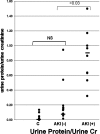MCP-1 gene activation marks acute kidney injury
- PMID: 21071523
- PMCID: PMC3014045
- DOI: 10.1681/ASN.2010060641
MCP-1 gene activation marks acute kidney injury
Abstract
Monocyte chemoattractant protein 1 (MCP-1) mediates acute ischemic and toxic kidney injury, but whether this can be used as a biomarker of acute kidney injury (AKI) is unknown. We obtained kidney and urine samples from mice with intrarenal (maleate), prerenal (endotoxemia), or postrenal (ureteral obstruction) injury. We also studied the independent effects of uremia without concomitant kidney injury by performing bilateral ureteral transection in mice. Additionally, we obtained urine samples from APACHE II-matched critically ill patients with or without advancing azotemia (n = 10 in each group). We assayed selected samples for MCP-1, MCP-1 mRNA, and for an activating histone mark (H3K4m3) at urinary fragments of the MCP-1 gene and contrasted the results with those obtained for neutrophil gelatinase-associated lipocalin (NGAL), a comparator "AKI biomarker" gene. Maleate increased urinary MCP-1 protein and mRNA more than the corresponding increases in NGAL. Endotoxemia and ureteral obstruction also increased NGAL and MCP-1 gene expression. Uremia, in the absence of renal injury, induced the NGAL gene, but not MCP-1, suggesting the possibility of better specificity of MCP-1 for AKI. Clinical assessments supported the utility of MCP-1 as a biomarker (e.g., nonoverlapping concentrations of urinary MCP-1 in patients with and without AKI). Elevated levels of urinary MCP-1 mRNA and levels of H3K4m3 at the MCP-1 gene supported MCP-1 gene activation in patients with renal injury. In conclusion, these data suggest that MCP-1 has potential as a biomarker of AKI and provide "proof of concept" that urinary histone assessments provide mechanistic insight among patients with kidney disease.
Figures










References
-
- Zager RA, Carpenter CB: Radioimmunoassay for urinary renal tubular antigen: A potential marker of tubular injury. Kidney Int 13: 505–512, 1978 - PubMed
-
- Herget-Rosenthal S, Poppen D, Hüsing J, Marggraf G, Pietruck F, Jakob HG, Philipp T, Kribben A: Prognostic value of tubular proteinuria and enzymuria in nonoliguric acute tubular necrosis. Clin Chem 50: 552–558, 2004 - PubMed
-
- Blaikley J, Sutton P, Walter M, Lapsley M, Norden A, Pugsley W, Unwin R: Tubular proteinuria and enzymuria following open heart surgery. Intensive Care Med 29: 1364–1367, 2003 - PubMed
-
- Kharasch ED, Frink EJ, Jr., Zager R, Bowdle TA, Artru A, Nogami WM: Assessment of low-flow sevoflurane and isoflurane effects on renal function using sensitive markers of tubular toxicity. Anesthesiology 86: 1238–1253, 1997 - PubMed
-
- Zager RA: Urinary protein markers of tubulointerstitial nephritis. Invest Urol 8: 197–202, 1980 - PubMed
Publication types
MeSH terms
Substances
Grants and funding
LinkOut - more resources
Full Text Sources
Research Materials
Miscellaneous

